您现在的位置是:主页 > news > 如何降低网站的权重/乔拓云智能建站平台
如何降低网站的权重/乔拓云智能建站平台
![]() admin2025/5/1 1:23:40【news】
admin2025/5/1 1:23:40【news】
简介如何降低网站的权重,乔拓云智能建站平台,安徽网站建设论坛,wordpress命令安装目录结构文章目录一、前言二、RabbitMQ 7种工作模式1、简单模式2、工作队列模式3、发布订阅模式4、路由模式5、主题模式(通配符模式)6、RPC模式7、Publisher Confirms三、测试api四、本文案例demo源码一、前言 SpringBoot整合RabbitMQ可参考:https://zhengqing.blog.csdn.n…
如何降低网站的权重,乔拓云智能建站平台,安徽网站建设论坛,wordpress命令安装目录结构文章目录一、前言二、RabbitMQ 7种工作模式1、简单模式2、工作队列模式3、发布订阅模式4、路由模式5、主题模式(通配符模式)6、RPC模式7、Publisher Confirms三、测试api四、本文案例demo源码一、前言
SpringBoot整合RabbitMQ可参考:https://zhengqing.blog.csdn.n…
文章目录
- 一、前言
- 二、RabbitMQ 7种工作模式
- 1、简单模式
- 2、工作队列模式
- 3、发布订阅模式
- 4、路由模式
- 5、主题模式(通配符模式)
- 6、RPC模式
- 7、Publisher Confirms
- 三、测试api
- 四、本文案例demo源码
一、前言
SpringBoot整合RabbitMQ可参考:https://zhengqing.blog.csdn.net/article/details/103785041
本文将基于springboot2.4.0来简单编写rabbitmq的7种工作模式demo ^_^
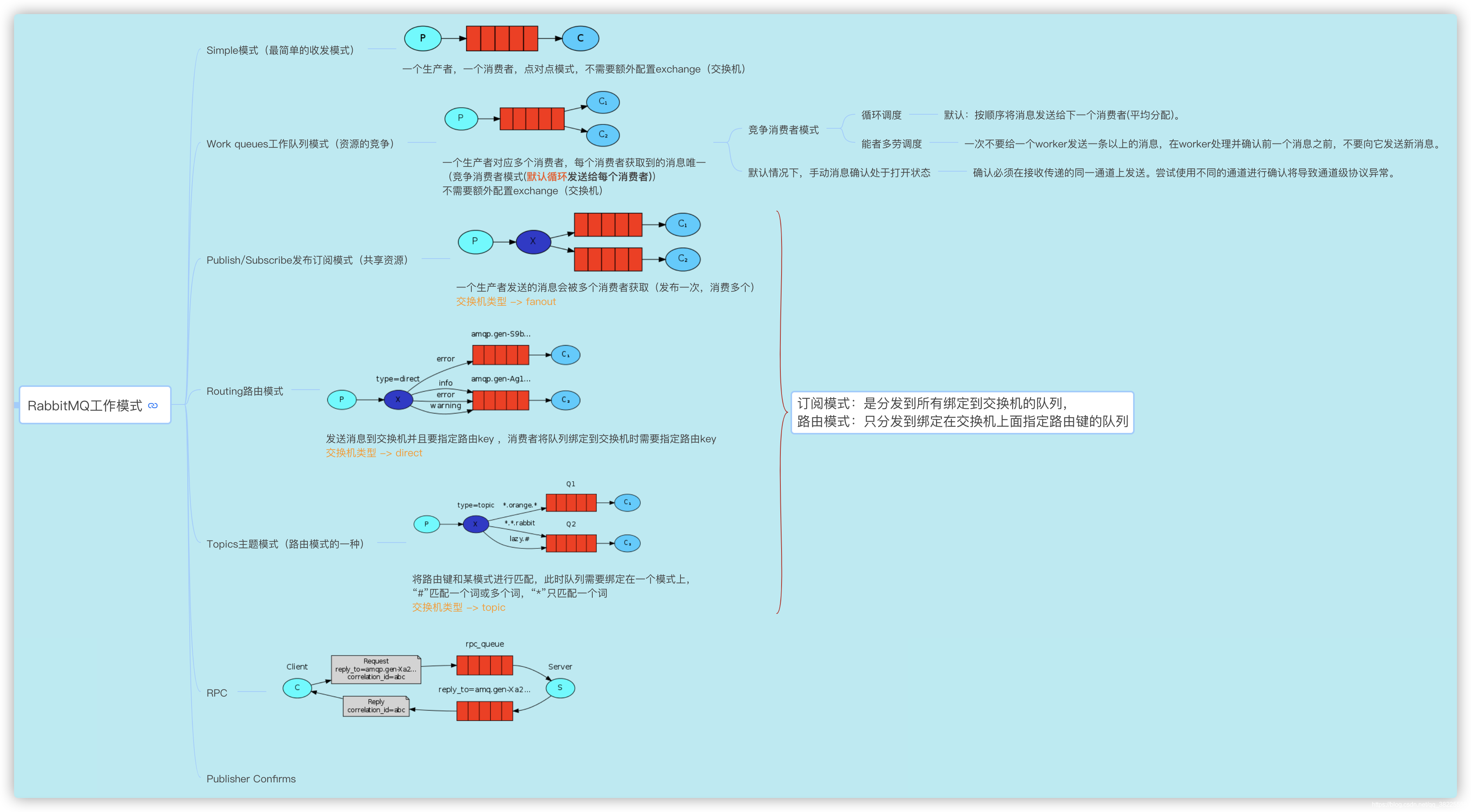
二、RabbitMQ 7种工作模式
可参考:https://www.rabbitmq.com/getstarted.html
工程如下:

MQ全局常用变量
public interface MqConstant {/*** 简单模式*/String SIMPLE_QUEUE = "simple_queue";/*** 工作队列模式*/String WORK_QUEUE = "work_queue";/*** 发布订阅模式*/String FANOUT_EXCHANGE = "fanout.exchange";String FANOUT_QUEUE_1 = "fanout_queue_1";String FANOUT_QUEUE_2 = "fanout_queue_2";/*** 路由模式*/String DIRECT_EXCHANGE = "direct.exchange";String DIRECT_QUEUE_1 = "direct_queue_1";String DIRECT_QUEUE_2 = "direct_queue_2";/*** 通配符模式*/String TOPIC_EXCHANGE = "topic.exchange";String TOPIC_QUEUE_1 = "topic_queue_1";String TOPIC_QUEUE_2 = "topic_queue_2";/*** RPC模式*/String RPC_QUEUE = "rpc_queue";}
1、简单模式

@Configuration
public class SimpleRabbitMqConfig {@Beanpublic Queue simpleQueue() {// durable: true 标识开启消息队列持久化 (队列当中的消息在重启rabbitmq服务的时候还会存在)return new Queue(MqConstant.SIMPLE_QUEUE, true);}}
@Slf4j
@Component
public class SimpleMsgProducer {@Autowiredprivate AmqpTemplate rabbitTemplate;public void send() {String msgContent = "Hello World";log.info("[生产者] 发送消息: {}", msgContent);this.rabbitTemplate.convertAndSend(MqConstant.SIMPLE_QUEUE, msgContent);}}
@Slf4j
@Component
public class SimpleMsgConsumer {@RabbitListener(queues = MqConstant.SIMPLE_QUEUE)public void listener(String msg) {log.info("[消费者] 接收消息: {}", msg);}}
2、工作队列模式
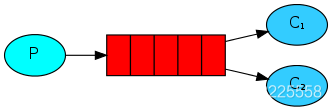
@Configuration
public class WorkRabbitMqConfig {@Beanpublic Queue workQueue() {// durable: true 标识开启消息队列持久化 (队列当中的消息在重启rabbitmq服务的时候还会存在)return new Queue(MqConstant.WORK_QUEUE, true);}}
@Slf4j
@Component
public class WorkMsgProducer {@Autowiredprivate AmqpTemplate rabbitTemplate;public void send() {String msgContent = "Hello World";log.info("[生产者] 发送消息: {}", msgContent);this.rabbitTemplate.convertAndSend(MqConstant.WORK_QUEUE, msgContent);}}
@Slf4j
@Component
public class WorkMsgConsumer {@RabbitListener(queues = MqConstant.WORK_QUEUE)public void listener1(String msg) {log.info("[消费者1] 接收消息: {}", msg);}@RabbitListener(queues = MqConstant.WORK_QUEUE)public void listener2(String msg) {log.info("[消费者2] 接收消息: {}", msg);}}
3、发布订阅模式

@Configuration
public class FanoutRabbitMqConfig {/*** 配置交换器*/@Beanpublic FanoutExchange fanoutExchange() {return new FanoutExchange(MqConstant.FANOUT_EXCHANGE);}/*** 配置队列*/@Beanpublic Queue fanoutQueue1() {return new Queue(MqConstant.FANOUT_QUEUE_1, true, false, false, null);}@Beanpublic Queue fanoutQueue2() {return new Queue(MqConstant.FANOUT_QUEUE_2, true, false, false, null);}/*** 配置绑定*/@Beanpublic Binding fanoutBinding1(FanoutExchange fanoutExchange, Queue fanoutQueue1) {return BindingBuilder.bind(fanoutQueue1).to(fanoutExchange);}@Beanpublic Binding fanoutBinding2(FanoutExchange fanoutExchange, Queue fanoutQueue2) {return BindingBuilder.bind(fanoutQueue2).to(fanoutExchange);}}
@Slf4j
@Component
public class FanoutMsgProducer {@Autowiredprivate AmqpTemplate rabbitTemplate;public void send() {String msgContent = "Hello World";log.info("[生产者] 发送消息: {}", msgContent);this.rabbitTemplate.convertAndSend(MqConstant.FANOUT_EXCHANGE, "", msgContent);}}
@Slf4j
@Component
public class FanoutMsgConsumer {@RabbitListener(queues = MqConstant.FANOUT_QUEUE_1)public void listener1(String msg) {log.info("[消费者1] 接收消息: {}", msg);}@RabbitListener(queues = MqConstant.FANOUT_QUEUE_2)public void listener2(String msg) {log.info("[消费者2] 接收消息: {}", msg);}}
4、路由模式
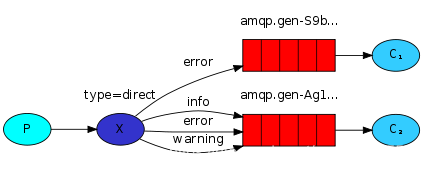
@Configuration
public class DirectRabbitMqConfig {/*** 配置交换机*/@Beanpublic DirectExchange directExchange() {return new DirectExchange(MqConstant.DIRECT_EXCHANGE);}/*** 配置队列*/@Beanpublic Queue directQueue1() {return new Queue(MqConstant.DIRECT_QUEUE_1, true, false, false, null);}@Beanpublic Queue directQueue2() {return new Queue(MqConstant.DIRECT_QUEUE_2, true, false, false, null);}/*** 配置绑定*/@Beanpublic Binding directBinding1(Queue directQueue1, DirectExchange directExchange) {return BindingBuilder.bind(directQueue1).to(directExchange).with("one");}@Beanpublic Binding directBinding2(Queue directQueue2, DirectExchange directExchange) {return BindingBuilder.bind(directQueue2).to(directExchange).with("two");}}
@Slf4j
@Component
public class DirectMsgProducer {@Autowiredprivate AmqpTemplate rabbitTemplate;public void send1() {String msgContent = "Hello World";log.info("[生产者1] 发送消息: {}", msgContent);this.rabbitTemplate.convertAndSend(MqConstant.DIRECT_EXCHANGE, "one", msgContent);}public void send2() {String msgContent = "Hello World";log.info("[生产者2] 发送消息: {}", msgContent);this.rabbitTemplate.convertAndSend(MqConstant.DIRECT_EXCHANGE, "two", msgContent);}}
@Slf4j
@Component
public class DirectMsgConsumer {/*** @RabbitListener 具有监听指定队列、指定exchange、指定routingKey的消息* 和建立队列、exchange、routingKey的功能*/@RabbitListener(bindings = @QueueBinding(value = @Queue(value = MqConstant.DIRECT_QUEUE_1, durable = "true"),exchange = @Exchange(value = MqConstant.DIRECT_EXCHANGE, type = "direct", durable = "true"),key = "one"))
// @RabbitListener(queues = MqConstant.DIRECT_QUEUE_1)public void listener1(String msg) {log.info("[消费者1] 接收消息: {}", msg);}@RabbitListener(bindings = @QueueBinding(value = @Queue(value = MqConstant.DIRECT_QUEUE_2, durable = "true"),exchange = @Exchange(value = MqConstant.DIRECT_EXCHANGE, type = "direct", durable = "true"),key = "two"))// @RabbitListener(queues = MqConstant.DIRECT_QUEUE_2)public void listener2(String msg) {log.info("[消费者2] 接收消息: {}", msg);}}
5、主题模式(通配符模式)
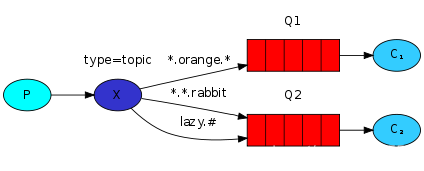
@Configuration
public class TopicRabbitMqConfig {/*** 配置交换器*/@Beanpublic TopicExchange topicExchange() {return new TopicExchange(MqConstant.TOPIC_EXCHANGE);}/*** 配置队列*/@Beanpublic Queue topicQueue1() {return new Queue(MqConstant.TOPIC_QUEUE_1);}@Beanpublic Queue topicQueue2() {return new Queue(MqConstant.TOPIC_QUEUE_2);}/*** 配置绑定*/@Beanpublic Binding topicBinding1(Queue topicQueue1, TopicExchange topicExchange) {// *:只能匹配一个词return BindingBuilder.bind(topicQueue1).to(topicExchange).with("topic.*");}@Beanpublic Binding topicBinding2(Queue topicQueue2, TopicExchange topicExchange) {// #:可匹配多个词return BindingBuilder.bind(topicQueue2).to(topicExchange).with("topic.#");}}
@Slf4j
@Component
public class TopicMsgProducer {@Autowiredprivate AmqpTemplate rabbitTemplate;public void send1() {String msgContent = "Hello World";log.info("[生产者1] 发送消息: {}", msgContent);this.rabbitTemplate.convertAndSend(MqConstant.TOPIC_EXCHANGE, "topic.one", msgContent);}public void send2() {String msgContent = "Hello World";log.info("[生产者2] 发送消息: {}", msgContent);this.rabbitTemplate.convertAndSend(MqConstant.TOPIC_EXCHANGE, "topic.one.two", msgContent);}}
@Slf4j
@Component
public class TopicMsgConsumer {@RabbitListener(queues = MqConstant.TOPIC_QUEUE_1)public void listener1(String msg) {log.info("[消费者1] 接收消息: {}", msg);}@RabbitListener(queues = MqConstant.TOPIC_QUEUE_2)public void listener2(String msg) {log.info("[消费者2] 接收消息: {}", msg);}}
6、RPC模式

@Configuration
public class RpcRabbitMqConfig {@Beanpublic Queue rpcQueue() {return new Queue(MqConstant.RPC_QUEUE);}}
@Slf4j
@Component
public class RpcMsgProducer {@Autowiredprivate AmqpTemplate rabbitTemplate;public void send() {String msgContent = "Hello World";log.info("[生产者] 发送消息: {}", msgContent);Object msgObj = this.rabbitTemplate.convertSendAndReceive(MqConstant.RPC_QUEUE, msgContent);log.info("[生产者] 接收回应:{}", msgObj);}}
@Slf4j
@Component
public class RpcMsgConsumer {@RabbitListener(queues = MqConstant.RPC_QUEUE)public String listener(String msg) {log.info("[消费者] 接收消息: {}", msg);return "消费者back";}}
7、Publisher Confirms
自己看官方文档吧…

三、测试api
编写controller,自己玩吧^_^
@Api(tags = "测试mq")
@RestController
@RequestMapping("/mq")
public class RabbitController {@Autowiredprivate SimpleMsgProducer simpleMsgProducer;@Autowiredprivate WorkMsgProducer workMsgProducer;@Autowiredprivate FanoutMsgProducer fanoutMsgProducer;@Autowiredprivate DirectMsgProducer directMsgProducer;@Autowiredprivate TopicMsgProducer topicMsgProducer;@Autowiredprivate RpcMsgProducer rpcMsgProducer;@ApiOperation("simpleQueue")@PostMapping("simpleQueue")public String simpleQueue() {this.simpleMsgProducer.send();return "SUCCESS";}@ApiOperation("workQueue")@PostMapping("workQueue")public String workQueue() {this.workMsgProducer.send();return "SUCCESS";}@ApiOperation("fanoutExchange")@PostMapping("fanoutExchange")public String fanoutExchange() {this.fanoutMsgProducer.send();return "SUCCESS";}@ApiOperation("directExchange1")@PostMapping("directExchange1")public String directExchange1() {this.directMsgProducer.send1();return "SUCCESS";}@ApiOperation("directExchange2")@PostMapping("directExchange2")public String directExchange2() {this.directMsgProducer.send2();return "SUCCESS";}@ApiOperation("topicExchange1")@PostMapping("topicExchange1")public String topicExchange1() {this.topicMsgProducer.send1();return "SUCCESS";}@ApiOperation("topicExchange2")@PostMapping("topicExchange2")public String topicExchange2() {this.topicMsgProducer.send2();return "SUCCESS";}@ApiOperation("rpcQueue")@PostMapping("rpcQueue")public String rpcQueue() {this.rpcMsgProducer.send();return "SUCCESS";}}
接口文档: http://127.0.0.1/doc.html
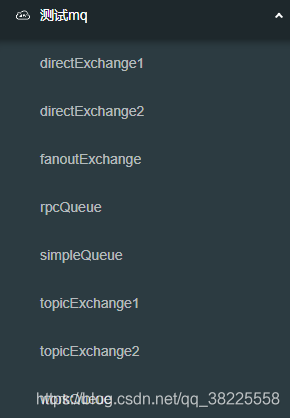
RabbitMQ


四、本文案例demo源码
https://gitee.com/zhengqingya/java-workspace
今日分享语句:
要想赢,就一定不能怕输。不怕输,结果未必能赢。但是怕输,结果则一定是输。








